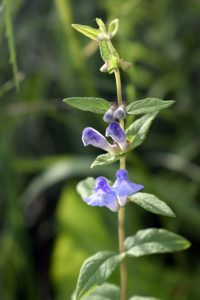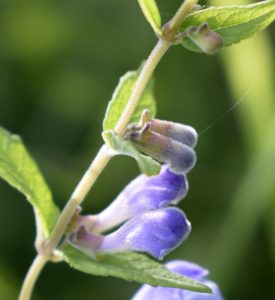Marsh Skullcap
 Scutellaria galericulata peeked out at me at eye level as I gingerly followed a swamp-loving friend deeper and further into his favorite milieu. On this lovely, early August day, he led the way along a narrow channel between the cattail reeds and saw grass. The water was dark in tone and thickly deep with loose humus and boggy muck. My friend suggested we put our hands down into the muck instead of walking, and in that way we slithered through like beavers. Welcome sights of respite during this once-is-great-enough experience were the wildflowers in their homes passing by. The white petals of arrowheads, for example, cheered me forward, and then the purple, tubular petals of marsh skullcap greeted me prettily in the height of their bloom season.
Scutellaria galericulata peeked out at me at eye level as I gingerly followed a swamp-loving friend deeper and further into his favorite milieu. On this lovely, early August day, he led the way along a narrow channel between the cattail reeds and saw grass. The water was dark in tone and thickly deep with loose humus and boggy muck. My friend suggested we put our hands down into the muck instead of walking, and in that way we slithered through like beavers. Welcome sights of respite during this once-is-great-enough experience were the wildflowers in their homes passing by. The white petals of arrowheads, for example, cheered me forward, and then the purple, tubular petals of marsh skullcap greeted me prettily in the height of their bloom season.
 Members of the Mint family share characteristics of opposite leaves, distinctly 4-sided/square stems, flowers with an upper and lower lip, and leaves that tend to be strongly scented when crushed. Marsh skullcap fits right in here, except that its leaves are not aromatic — an identifier in itself. Look for overall fuzziness of the flowers, undersides of leaves and along the corner edges of the square stem. An interesting detail is the smallish, red-tinted ridge on the calyx top. Inside the calyx, nutlet seeds will form later on. Leaves are lance-shaped and somewhat narrow, up to a little over 2 inches long, with bluntly toothed edges.
Members of the Mint family share characteristics of opposite leaves, distinctly 4-sided/square stems, flowers with an upper and lower lip, and leaves that tend to be strongly scented when crushed. Marsh skullcap fits right in here, except that its leaves are not aromatic — an identifier in itself. Look for overall fuzziness of the flowers, undersides of leaves and along the corner edges of the square stem. An interesting detail is the smallish, red-tinted ridge on the calyx top. Inside the calyx, nutlet seeds will form later on. Leaves are lance-shaped and somewhat narrow, up to a little over 2 inches long, with bluntly toothed edges.
Flowers appear in pairs growing out of each leaf axil adjacent to the main stem (and also on shorter stems that occasionally branch out from the main stem). Purple and trumpet-shaped, the flower name comes from the hooded upper lip that forms over the mouth of the lower lip throat opening into the tube. Being covered with fine hairs, they resemble fuzzy little caps or hoods; before the flowers open they are more like a pair of furry slippers! The rather spindly stems don’t need to be strong, as they are held up just fine between the green blades of foliage within the swamp and along the lakeshore. Nearby neighbors also taking up residence between the thickly spaced swamp grasses and reeds include a plethora of other moisture loving, summer blooming flowers such as marsh bellflower, boneset, blue lobelia, jewelweed, northern bugleweed, and bulblet bearing water hemlock. Each of these flower species has their own unique place in the ecosystem. Daily, they send out their individual invitations for visitors to take a closer look and even venture inside their delightful homes. All they need to do is be themselves in their habitat!
As for me, when I crawled back out of our adventure in the swamp, I immediately headed for my own favorite spot in the sandy shallows of clean, clear lake water. There I rinsed off some of the accumulated detritus while planning my return trip with camera — the intent being to accept every one of those many flower invitations received with the stipulation that our visits take place anywhere but in the swamp muck!
